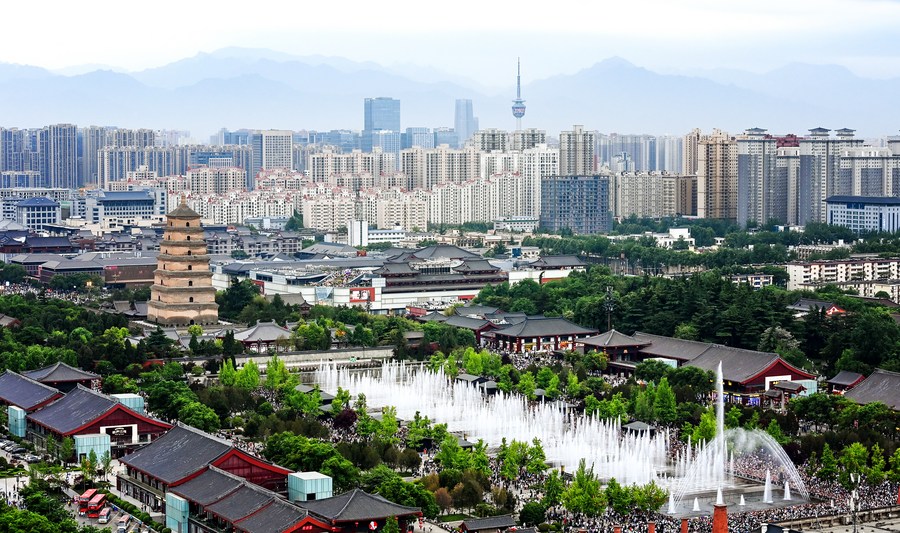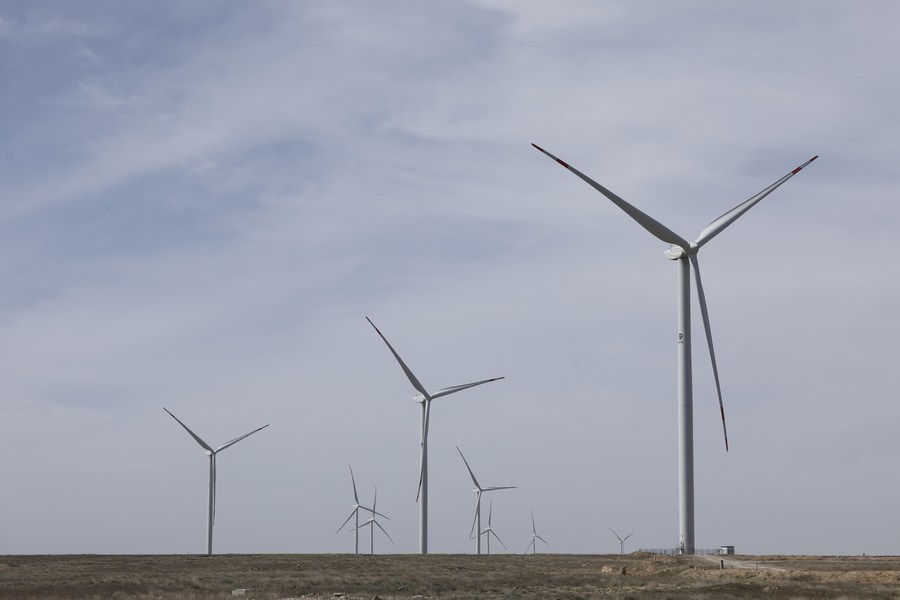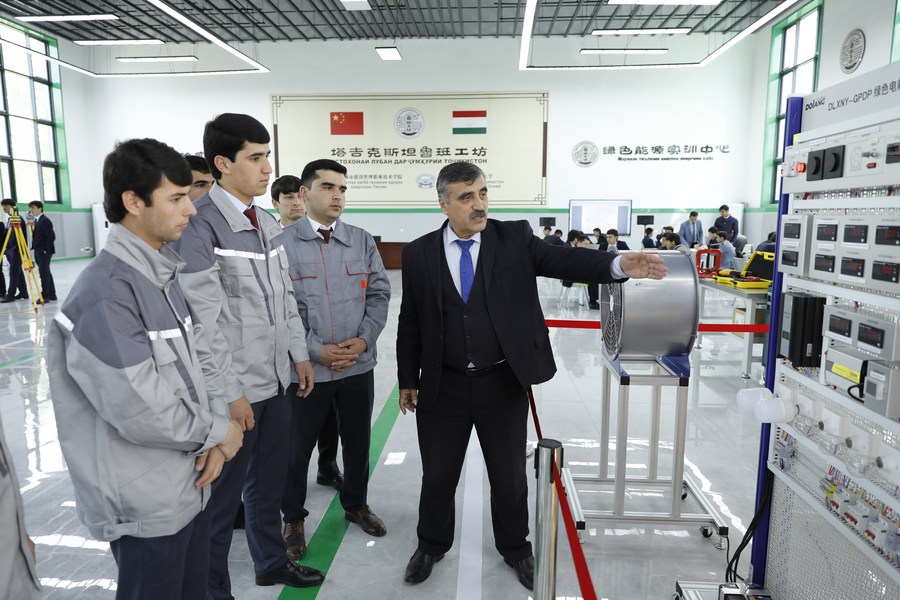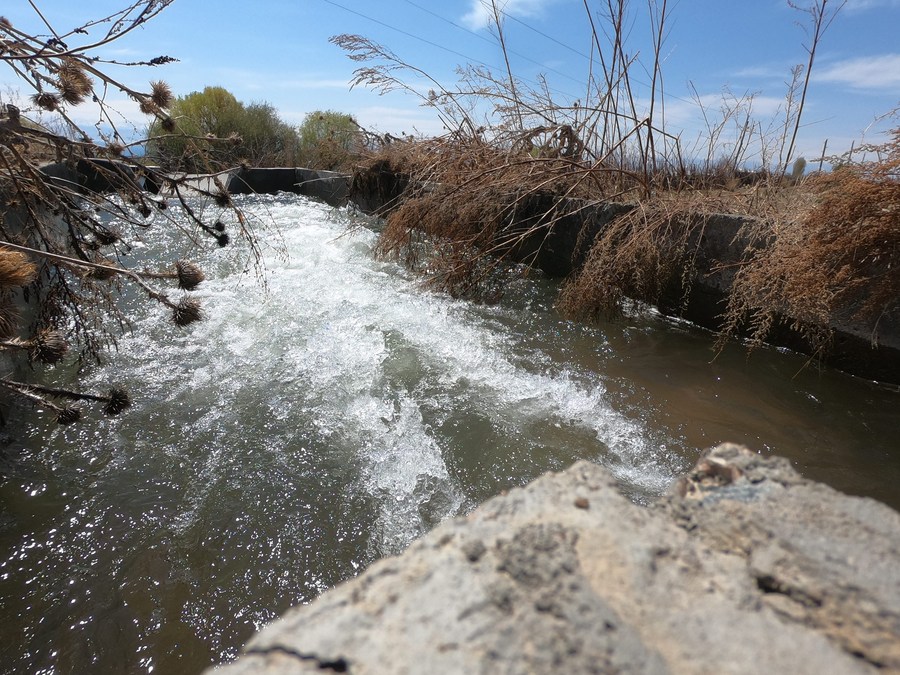




- BRNN
- BRI News
- BRNN News
- Database
Official Documents Polices and Regulations
Inter-government Documents International Cooperation BRI Countries
Business Guide Economic Data BRI Data
Trade
Investment Projects Latest projects
Cases - Content Pool

Chinese President Xi Jinping and his wife Peng Liyuan head for the venue of a welcome banquet along with guests in Xi'an, northwest China's Shaanxi Province, May 18, 2023. (Xinhua/Huang Jingwen)
BEIJING, May 19 (Xinhua) -- Che Xueling, general manager of an export company at Horgos, a border city in Xinjiang that used to be a trading post along the northern route of the ancient Silk Road, has been heartened by the profound changes the city and her business are undergoing.
"In earlier years we exported sundry goods through the dirt roads," Che recalled. In recent years, thanks to the burgeoning cooperation between China and Central Asia as well as improved customs clearance and simplified procedures, things have changed. "Now all kinds of Chinese-made vehicles are exported to Central Asian countries through the wide tarmac road at the port," said Che.
In the first three months of the year, Che's company has exported more than 1,000 commercial vehicles worth some 30 million U.S. dollars. Meanwhile, in the first quarter, the port of Horgos handled 1,833 freight trains connecting China with European and Central Asian countries, registering a record-high increase of 8.4 percent year on year.
The growth of Horgos and the boom of Che's business epitomize the ever-closer relations between China and the five Central Asian countries, namely Kazakhstan, Kyrgyzstan, Tajikistan, Turkmenistan and Uzbekistan, where the ancient Silk Road passed through.
With their joint efforts over the past years, especially since 2013 when China proposed the Belt and Road Initiative (BRI), the age-old trade route that embodied the spirit of cooperation, mutual learning and mutual benefit has revived and grown into a path of common development, bringing tangible benefits to the region and the world at large.
REVIVED ANCIENT SILK ROAD
In history, the Silk Road had been a vital corridor connecting the East and West since some 2,000 years ago. Its name was derived from the lucrative trade in Chinese silk carried along the route. Ten years ago, during his Kazakhstan visit, Chinese President Xi Jinping proposed that China and Central Asia join hands to build a Silk Road Economic Belt to boost cooperation.

This photo taken on May 1, 2023 shows a view of the Giant Wild Goose Pagoda in Xi'an, northwest China's Shaanxi Province. (Photo by Zou Jingyi/Xinhua)
"It is important that we continue to set the pace for Belt and Road cooperation and deliver on the Global Development Initiative. We should fully unlock our potentials in traditional areas of cooperation such as economy, trade, industrial capacity, energy and transportation. And we should forge new drivers of growth in finance, agriculture, poverty reduction, green and low-carbon development, medical service, health, and digital innovation. We should work together to ensure that our community features win-win cooperation and common progress," Xi said Friday while delivering a keynote speech at the China-Central Asia Summit held in the city of Xi'an, northwest China's Shaanxi Province.
Xi's inspiring visions and strategic guidance have helped revitalize the ancient route and injected impetus into China-Central Asia cooperation.
Over the past decade, trade between China and the five Central Asian countries has maintained robust growth momentum. The latest official figures showed that last year, trade between the two sides reached a historic high of 70.2 billion U.S. dollars. In the first three months of this year, their trade surged 22 percent year on year.
Agriculture is a major area of cooperation between China and Central Asian countries. A great variety of Central Asian agricultural products have entered the Chinese market, including camel milk from Kazakhstan, honey from Kyrgyzstan, dried fruits from Tajikistan, cotton from Turkmenistan, and cherries from Uzbekistan. Last year, China's imports of agricultural, energy and mineral products from these countries jumped over 50 percent.
Central Asia is also an important energy supplier to China. China received 30 percent of its natural gas imports through the China-Central Asia pipeline in 2022.
In addition to these traditional fields of cooperation, China and Central Asian countries are working together to promote new patterns in trade and investment, giving priority to innovation and green development.
Maksat Abilgaziev, 33, is a Kazakh born and raised in Zhanatas, a run-down town in the country's south that was once a thriving center of phosphate mining and fertilizer production.

This photo taken on April 3, 2023 shows some wind turbine generators of the 100-MW Zhanatas wind farm in Zhanatas, Kazakhstan. (Photo by Kalizhan Ospanov/Xinhua)
In 2020, Abilgaziev quit his electronic engineering job at a local phosphate mine, and became a wind power engineering trainee at the Chinese-built Zhanatas wind farm, one of the largest of its kind in Central Asia.
"Our Chinese friends have brought equipment, investment, technology and experience to Kazakhstan. They have also cultivated clean energy talents in our country. The wind power projects have created jobs and tax revenues for Zhanatas, bringing the town back to life," said Abilgaziev, whose income has more than doubled in three years.
Meanwhile, modern technology has further energized trade between China and Central Asia. Official figures showed that in 2022, the cross-border e-commerce trade between the two sides has increased by 95 percent year on year, with nearly 300 Central Asian enterprises selling quality products on Chinese e-commerce platforms.
ENHANCED INTERCONNECTIVITY
The first passenger flight route between Xi'an and Ashgabat, capital of Turkmenistan, was officially launched on Saturday.
Gulshada Urazalieva, an independent Uzbek analyst, said that the opening of flights between Xi'an and cities of Central Asia is of great significance, as they will promote economic and cultural exchanges between China and the region.
The world needs an interconnected Central Asia, Xi stressed at the summit, adding that blessed with unique geographical advantages, Central Asia has the right foundation, condition and capability to become an important connectivity hub of Eurasia and make unique contributions to the trading of goods, the interplay of civilizations and the development of science and technology in the world.
In addition to launching more direct flights to connect their cities, China and Central Asian countries have also planned and implemented multiple infrastructure projects within the framework of the BRI.
In September 2022, China, Kyrgyzstan and Uzbekistan signed a memorandum of understanding on cooperation on the Kyrgyz section of the China-Kyrgyzstan-Uzbekistan railway, making significant headway in the construction of a transport corridor in the Eurasian continent.
Meanwhile, the China-Europe freight trains through Central Asia, the China-Kazakhstan Horgos International Frontier Cooperation Center, and the China-Kazakhstan International Logistics Base in the eastern Chinese port of Lianyungang have all helped open the door to global markets for Central Asian countries.
The projects have not only promoted commercial activities among the six countries, but also brought people living in the region closer through cultural and people-to-people exchanges. At present, there are five Confucius Institutes established in Kazakhstan, providing Chinese language training for over 3,000 people each year, while four universities in China have opened institutes on Kazakhstan studies and two have added the Kazakh language as a major. By the end of 2021, the cumulative number of international students studying in each other's countries had reached 15,100.

A Tajik professor introduces to students a green electrical energy device at the Luban Workshop in Dushanbe, Tajikistan, April 12, 2023. (Photo by Kalizhan Ospanov/Xinhua)
Another exemplar of people-to-people exchanges between China and Central Asia is the Luban Workshop in Dushanbe, a Chinese vocational workshop program training talents in Tajikistan. The workshop, officially going into service in November 2022, is the first of its kind in Central Asia.
"China's Luban Workshop is recognized as an international vocational education brand worldwide. We believe that Luban Workshop will be of great help to Tajik Technical University in training talents in measurement, green energy and heating," said Shahriyor Sadullozoda, vice rector of Tajik Technical University.
TOWARD A SHARED FUTURE
For villagers living in Kara-Oi on the northern shore of Issyk-Kul Lake, Kyrgyzstan, irrigation was once a headache. The old irrigation system built decades ago could not meet the growing water demands.
"Water is not enough. Constant queues, it is very difficult to get water in a timely manner," said Evgeny Yakovlev, a farmer who needs to water his field at least three times a day in summer.
To solve the water problem in Kara-Oi and villages alike, the Kyrgyz government initiated a project in May 2018 allocated from a Chinese grant to reconstruct the country's irrigation system.

This photo taken on April 24, 2023 shows a flume rebuilt under a project allocated from a Chinese grant to reconstruct Kyrgyzstan's irrigation system at Kara-Oi village in Issyk-Kul region, Kyrgyzstan. (Photo by Chingiz/Xinhua)
Under the project, a reservoir was built by China Railway No.5 Engineering Group Co., Ltd in Kara-Oi with a capacity of 470,000 cubic meters of water. A total of 330 hectares of undeveloped land were put into operation, and the water supply was increased on an area of over 1,000 hectares.
"Before, it was very difficult with water ... Now it's better. We are grateful to the builders," said Arstanbek Zhundubaev, head of the Water Users Association of Kara-Oi.
It is heartwarming episodes like this one that have formed a stirring symphony of Chinese and Central Asian people supporting each other to pursue common prosperity and achieve a brighter future.
Central Asia is not only geographically adjacent to China, but also very closely connected with China, especially in the fields of economy, trade, finance and credit, said Kubanychbek Taabaldiev, a Kyrgyz political scientist and professor of international relations at Ala-Too International University.
"Central Asia is located along the ancient Silk Road, and all countries in the region have participated in the Belt and Road Initiative in different ways," he said. "All countries in the Central Asian region are implementing bilateral projects with China, which benefits all parties."
The BRI has been very fruitful since it was first proposed by China in Kazakhstan, said Timur Kuvatov, director-general and editor-in-chief of Kazakhstan Today News Agency.
Reviving the visions and spirits embodied in the ancient Silk Road will promote international development and trade and economic ties, as well as peaceful relations among countries, he said, adding that deeper Belt and Road cooperation has great significance for all the people living in the region and the whole world.
"Let us work closely together to pursue common development, common affluence, and common prosperity, and embrace a brighter future for our six countries!" Xi urged at the summit.

Tel:86-10-65368972, 86-10-65369967